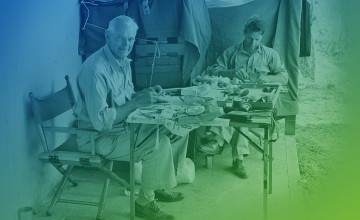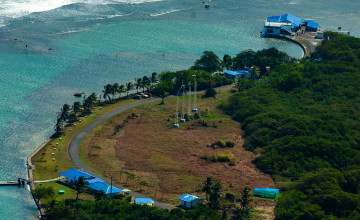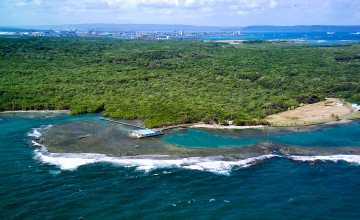
The Panama Canal’s watershed, in essence the Chagres river, is one of the most important in the world, on par with the Nile or the Rhine. Every year, its waters move some 14,000 ships through this vital interoceanic trade route. It is also the source of fresh water for 80% of Panama’s urban population and industry.
Research Focus
During the 1970s and 1980s, I worked in community development, land-tenure and environmental projects with rural and indigenous communities in Panama and Central America. It helped me gain lots of hands-on experience and to work, within the government, towards the creation of Panama’s National Parks System and legalize the status of the country’s indigenous territories. From 1987-1990, I was senior social scientist at the Tropical Agronomic Center for Research and Teaching (CATIE) in Costa Rica.
I became affiliated with STRI in 1983 as a research associate. In 1989, following the U.S. invasion of Panama, I served as director of today’s environment ministry. From 1996-2000, I led STRI’s Panama Canal Watershed Natural Resources Monitoring Project. I was part of a small team that worked toward the creation of the Panama Canal Authority (ACP) and the key decision of turning the forest of the former Canal Zone into protected areas.
Since 2000, I have been responsible for STRI’s Galeta Point Marine Laboratory in Colón. Galeta does research on tropical coastal habitats, carries out a dynamic education and public outreach programs, and since 2007, trains Panamanian teachers on how to do and teach science. I have authored and coauthored books and hundreds of articles, some on the environmental challenges facing the Isthmus of Panama, others on history of natural history in Panama and the Americas.
Contact
Research Overview
In a country of merchants, commerce and trade, how do you make science important?
A 'natural' disaster does more to interest decision-makers in science than any number of publications. After devastating floods on Panama's Caribbean coast, in the port city of Colón, people began to ask if it had been a good idea to destroy the mangroves and landfill its estuaries. Disasters underscore the importance of the research on tropical coastal ecosystems at Galeta and educating the citizens.
Can development and conservation coexist in the Panama Canal Watershed?
It is hard for conservation and development to coexist. However, the case of the Panama Canal Watershed proves it can be done. This small watershed, only 3,300 square kilometers, provides fresh water in astronomical quantities so the canal can move over 14,000 ships yearly between the Atlantic and Pacific. It also provides hundreds of millions of gallons of high-quality water daily for eight aqueducts that supply 80 percent of the country’s urban population and industry. The canal’s economic success and the quickly expanding economy of canal-connected activities are placing great pressure on the watershed’s and particularly on the coastal habitats on both entrances of the waterway. The health of the canal watershed is not up for discussion. The future of Panama’s economy and the health of 80 percent of the population and industry depends on protecting the forests of the Chagres river basin and Panama’s coastal ecosystems.
Who were the first naturalists to study the plants and animals of the Isthmus of Panama?
Life leads you in unexpected turns. By the 1990s, the Smithsonian had been in Panama more than 80 years but Panamanians knew little about STRI or what it did. In 1995, the director of Épocas, a local historical and cultural review, asked me to write four articles on how STRI came to Panama. These articles well received — especially local teachers who had no resources on the history of the early naturalists who visited the Isthmus— so Épocas asked to keep up the monthly articles. By 2017, I’d written 250 articles. It’s been fascinating to learn about these men and women (not uncommon in the sciences in the 19th century but often overlooked); this quest of these pioneers led me beyond Panama to Central America, Mexico and South America. These articles can be accessed via SRO, Smithsonian Research on Line.
How do we make STRI research relevant to Panama’s schoolchildren?
Making Smithsonian science relevant in Panama has been a challenge. For much of its history, the Smithsonian was confined to Barro Colorado Island in Gatún Lake in the U.S.-run Panama Canal Zone — a bubble within a bubble. Visiors needed not learn Spanish.
When I came to STRI in the 1990s, few Panamanians knew what the institute did. Bridges had to be built. One, providing schoolteachers with resources such as the history of natural history articles; they were published in books and are now used by school teachers. When I came to Galeta, on finding that teachers hardly knew anything on corals, mangroves, sea grasses or the creatures that live there, in 2007, we started a two-week intensive teacher training course on tropical coastal habitats. We take in 40 school teachers yearly. So far, more than 450 teachers from all over Panama have graduated from this program. This is an effort that joins forces of the Ministry of Education, STRI and the International Community Foundation, our donor. We evaluate docents at the start and at the end of the course and the differences are stunning. They learn a lot on how to do science, in the field and the classroom, and how to make if fun. The Ministry of Education considers the Galeta course the best in Panama.
How do we make private companies good environmental neighbors?
Panama’s second city, Colón, is at the Caribbean entrance to the Panama Canal and home to Latin America’s busiest ports and a massive free-trade zone. Rapidly expanding infrastructure places considerable pressure on the mangroves, reefs and seagrasses. To protect Galeta we have had to engage directly and face-to-face the companies, some of them very large. We have been able to obtain a buffer zone for the protected area around the Galeta Point Marine Lab. Companies have also provided scholarships to 60 financially limited senior college students so they can carry field work at Galeta, analyze their data, complete their thesis and graduate. Many have gone on to graduate studies.
How can our research and education programs contribute to the conservation of coral reefs, seagrass beds and mangroves?
At Galeta conservation started with our environmental education program, based on our scientific research. To save these coastal habitats teachers and students needed to know how valuable these habitats are. One needs realize almost 90 percent of the country’s population lives on the coast of both oceans or within a few kilometers. So, in 2000, we began our education program aimed at the Colón public schools. Our first guests, 60 children from Casa Esperanza, a Catholic institution working with children in situations of social risk. By 2015, over 110,000 students from all provinces and indigenous territories have participated in our education program. Now we have a growing number of schools that look to Galeta as their place to field work and learn. Dozens of students do volunteer work at the station, many go on to become guides in training, guides and later senior guides. Some earn scholarships and do their undergraduate or graduate theses at the station. In 2004 we began our public outreach program, the Charlas Smithsonian del Mes, our monthly talks by STRI researchers. These are held in town at Fort De Lesseps inside the Morgan Battery firs gun emplacements to protect the canal back in 1910. Our audience is made of nature and tourist guides, flower lovers, taxi drivers, college students, members of nongovernmental organizations, port workers and professionals.
Education
B.A., Universidad de los Andes, 1970.
M.A., University of Essex, 1973.
Ph.D., University of Essex, 1983.
Selected Publications
Heckadon-Moreno, Stanley y Alberto McKay. 1982. Colonizacion y Destruccion de Bosques en Panama. (174pp).
Heckadon-Moreno, Stanley. 1983. Cuando se Acaban Los Montes. (172pp)
Heckadon-Moreno, Stanley and Espinoza Gonzalez, Jaime. 1985. Agonia de la Naturaleza. (327pp).
Heckadon-Moreno, Stanley. 1986. La Cuenca del Canal de Panama. Actas de los Seminarios Talleres. II volumes. (380pp)
Heckadon-Moreno, Stanley. 1990. Madera y Leña de Las Milpas. Los Viveros Comunales en El Salvador. (88pp)
Heckadon-Moreno, Stanley. 1990. Panama y sus Usos y Costumbres. (650pp)
Heckadon-Moreno, Stanley. 1995. Agenda Ecologica y Social Para Bocas del Toro. (150pp) STRI-Paseo Pantera.
Panama: Puente Biologogico: las charlas Smithsonian del Mes 1996-99. STRI (233pp) Heckadon-Moreno, Stanley. 2001.
Heckadon-Moreno, Stanley. 1998. Naturalistas Del Istmo De Panamá : Un Siglo De Historia Natural Sobre El Puente Biológico De Las Américas Smithsonian Tropical Research Institute and Fundación Santillana para Iberoamérica. 215 pages.
Heckadon-Moreno, S. 2004. Naturalists of the Isthmus of Panama. A Hundred Years of Natural History on the Biological Bridge of the Americas Smithsonian Tropical Research Institute.
Heckadon-Moreno, Stanley. 2006. Selvas Entre Dos Mares . Expediciones Cientificas al Istmo de Panama, siglos XVIII-XX. Smithsonian Tropical Research Institute, (312pp)
Heckadon-Moreno, Stanley. 2007. Cuando se acaban los montes Panamá: Editorial Universitaria. Instituto Smithsonian de Investigaciones Tropicales.
Heckadon-Moreno, Stanley. 2009. De Selvas a Potreros: La Colonización Santeña en Panamá: 1850-1980. Exedra Books, Panamá, 300 pages.
Heckadon Moreno, Stanley. 2011. A Creole from Bocas del Toro: The story of Carlos Reid. Panama: ExedraBooks.
Exploraciones del geólogo Robert Stewart en Darién, 1947. Épocas, 28(3): 10-11.
Heckadon-Moreno, Stanley. 2012. Neville Harte y las piedras pintadas de Panamá. Épocas, 27(8): 10-11.
Heckadon-Moreno, Stanley. 2012. El último río del último pueblo. In: Chen Barría, José, Ser Chiricano. David, Panamá: Impresos Modernos, S.A, pp.103-120.
Heckadon Moreno, Stanley. 2010. Alexander Wetmore y Armagedón Hartmann en el Golfo de San Blas, 1957. Épocas, 25(9): 10-11.
Heckadon-Moreno, Stanley. 2009. Alexander Wetmore y Armagedón Hartmann en Coiba y Coibita, 1956. Épocas, 24(11): 2-3.
Heckadon-Moreno, Stanley. 2008. Alexander Wetmore y Watson Perrygo en la Serranía de Majé, 1950. Épocas, 23(9): 10-11.
Heckadon-Moreno, Stanley. 2006. Las Tres Décadas De Fausto Bocanegra En Barro Colorado. Epocas , 4: 10-11.
Heckadon-Moreno, Stanley, Ibáñez D., Roberto and Condit, Richard S. 1999. La Cuenca Del Canal: Deforestación, Urbanización y Contaminación Smithsonian Tropical Research Institute. 120 pages.
Heckadon-Moreno, Stanley. 1998. El Naturalista y Americanista Tadeo Haenke En Panamá, 1790. Epocas , 5: 2-3.
Heckadon-Moreno, Stanley. 1997. Spanish rule, independence, and the modern colonization frontiers. In: Coates, Anthony G., Central America: A Natural and Cultural History. New Haven: Yale University Press, 177-214.


